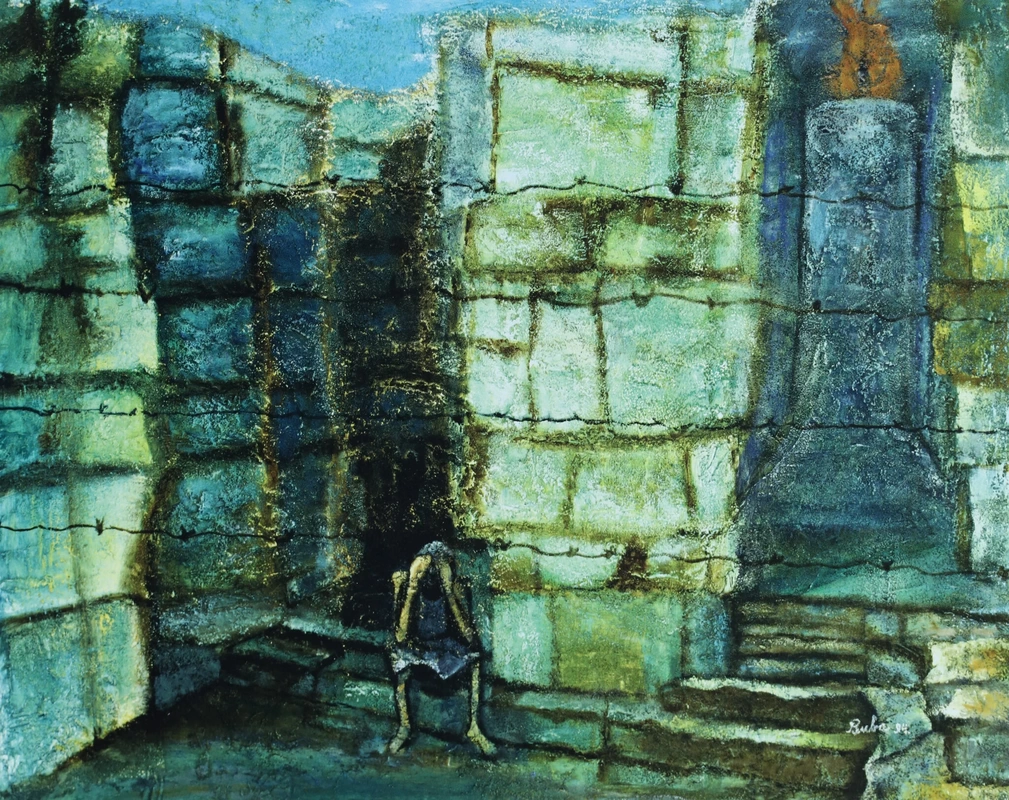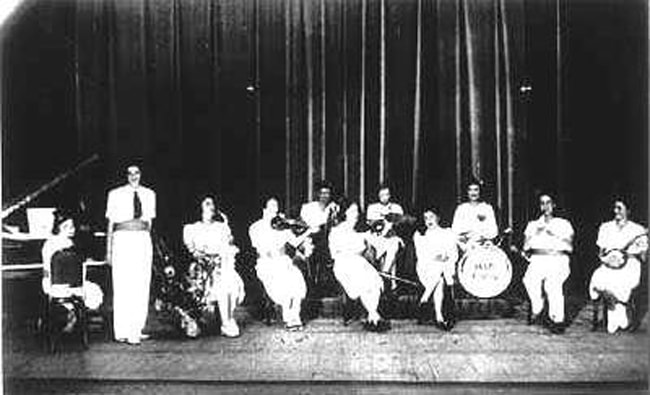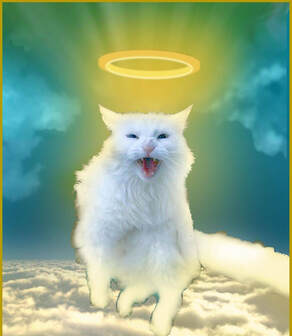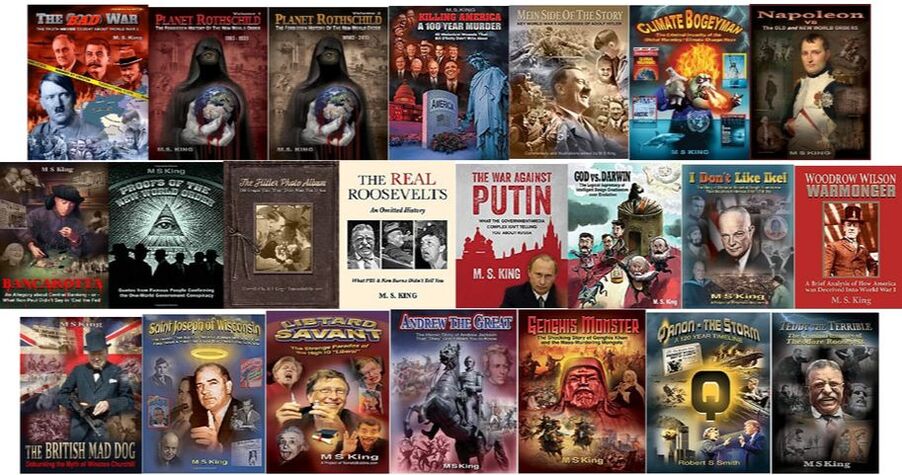|
HITLER's BIRTHDAY FUNDRAISER & SPECIAL PRIZES "LOTTERY"
Enter Now -- Winner selected on April 20th! DETAILS HERE |
The Slimes' in-house "conservative," Bret Stephens (cough cough), is a "Pulitzer Prize winner" ™ who previously wrote for The Wall Street Urinal and The Jerusalem Compost. In this particular Op-Ed about the sad song that never ends about the event that never happened, Mr. Ehrlich (his original family name) introduces us about an old yenta named Buba Weisz Sajovits -- who (like so many others) survived the Bullschwitz concentration camp and lived to invent (and paint) stories about it. Without intending to do so, Stephens and Sajovits make a good comedy team. Let's clean-up this garbage and have a few laughs.
*********************
Stephens: When Buba Weisz Sajovits arrived in Veracruz in 1946, their eldest sister, Bella, who had been in Mexico with her husband from the 1930s, insisted that they were not to speak of what had happened to them in the war. Life was meant to be lived facing the future, not the past. So Buba — her given name is Miriam — lived life forward.
Rebuttal: Well, good for Buba/Miriam for putting Bullschwitz behind her and "living life forward!"
Stephens: Only one reminder of the past could not be erased, because it was etched permanently in ink on the inside of her left forearm: A-11147.
Rebuttal: Ya see, if it hadn't been for that darn tattoo, she would have gotten over the trauma by now.
Stephens: What went with that alphanumeric was, as she would title her memoir, “Tattooed in My Memory.”
Rebuttal: A memoir, eh? What happened to "living life forward?" Ah, show us the shekels, Buba. Show us the shekels.
Stephens: Decades later, when she was well into her 60s, she decided to take up painting, and soon the past became more vivid.
Rebuttal: Wait till you see these twisted masterpieces!
Stephens: How can we really comprehend an event like the Holocaust, or a place like Auschwitz?
Rebuttal: We cannot "comprehend" it because it never happened as Stalin's "investigators" said that it did.
*********************
Stephens: When Buba Weisz Sajovits arrived in Veracruz in 1946, their eldest sister, Bella, who had been in Mexico with her husband from the 1930s, insisted that they were not to speak of what had happened to them in the war. Life was meant to be lived facing the future, not the past. So Buba — her given name is Miriam — lived life forward.
Rebuttal: Well, good for Buba/Miriam for putting Bullschwitz behind her and "living life forward!"
Stephens: Only one reminder of the past could not be erased, because it was etched permanently in ink on the inside of her left forearm: A-11147.
Rebuttal: Ya see, if it hadn't been for that darn tattoo, she would have gotten over the trauma by now.
Stephens: What went with that alphanumeric was, as she would title her memoir, “Tattooed in My Memory.”
Rebuttal: A memoir, eh? What happened to "living life forward?" Ah, show us the shekels, Buba. Show us the shekels.
Stephens: Decades later, when she was well into her 60s, she decided to take up painting, and soon the past became more vivid.
Rebuttal: Wait till you see these twisted masterpieces!
Stephens: How can we really comprehend an event like the Holocaust, or a place like Auschwitz?
Rebuttal: We cannot "comprehend" it because it never happened as Stalin's "investigators" said that it did.
Stephens: I’ve made the trip to Auschwitz, walked along the infamous rail tracks
Rebuttal: There were railroad tracks leading to Bullschwitz -- proving what, exactly?
Stephens: ... toured the crematory,...
Rebuttal: Assuming the "crematory" which you saw was even genuine, that would only prove that those who died of natural causes at the camp were cremated. So?
Stephens: ... peered at the vast piles of shoes...
Rebuttal: Assuming that the "vast pile of shoes" that you saw weren't a museum prop, that would only prove that the inmates were given uniform shoes. So? (Why would the "Nazis" preserve all those shoes anyway?)
Stephens: ...the sickening mounds of human hair.
Rebuttal: So the Germans saved up "mounds" of Jewish hair but cremated the bodies? Makes perfect sense. (rolling eyes) -- Were they going to make frickin' wigs with the lice-infested hair?!
Stephens: We know that 1.1 million were murdered at Auschwitz, mostly in gas chambers.
Rebuttal: We do? Tell me, Stephens, how exactly do we "know?" (FYI: for nearly 50 years, (((they))) told us the number was 4 million!)
Stephens: We have thousands of testimonials from the camp’s survivors....
Rebuttal: The camps were loaded with notoriously dishonest Communists --- and the fact that so many "survived" constitutes clear evidence that there was no mass extermination program going on.
Stephens: .... and (testimonials from) its liberators, masses of documentary and photographic evidence ...
Rebuttal: Dude! The "liberators" of Bullschwitz were the Soviets! No westerner ever got to see the eastern camps. Belief in the Holohoax necessarily requires us to place blind faith in the "documentary and photographic evidence" of Stalin's "Extraordinary State Commission." No thanks!
Stephens: ... the autobiography and signed affidavit of its commandant.
Rebuttal: The cruel All-Lies said to Commandant Rudolf Hoess: "Confess to this and sign it, or you die." Hoess did exactly that -- and was executed anyway, in Stalin's communist Poland, in 1947. Prior to his execution, under the orders of Poland's Communist authorities (here), Hoess wrote his "autobiography," released in English under the title Commandant of Auschwitz: The Autobiography of Rudolf Hoess. ---Sorry Stephens. You'll have to do better than that.
Stephens: Yet as details accumulate, they numb as much as they inform. Information becomes statistical; statistics become abstractions. Personal memoirs, such as Primo Levi’s “Survival in Auschwitz,” restore the human dimension, but there’s always a zone of uncertainty between the written word and the reader’s imagination. Movies like “Schindler’s List” also bring to life the human element, but at the peril of semi-fictionalization. They can make Auschwitz seem less real, not more.
Analysis: If you read that excerpt closely, or better yet, read it again --- what Stephens is essentially saying is this: "Because the hard evidence isn't really there, personal memoirs and films play an important role in keeping the scam alive." That's where Buba's "paintings" come in.
Stephens: When Buba began to paint, “she couldn’t make a circle,” her daughter Monica recalled. “But whatever she did in life, she took to the limit and was good.”
Analysis: We're getting to the fun part.
Stephens: Buba was given a factory job. One day, she was called into a cubicle of the female prisoner who was in charge of barracks discipline. She tore off Buba’s clothes and shoved her toward a man who had been waiting for her. “I gathered every last ounce of strength that I could muster,” she said, “and ran.” How can we understand what it’s like to be a half-starved, naked Jewish girl running for her life from an Auschwitz rapist? We can’t. I can’t.
Analysis: I can't understand it either, Stephens -- because in the German military, the penalty for rape was death.
Stephens: But in 2002, Buba painted the scene, and through her painting I could catch a glimpse of what it means to be the most vulnerable person on earth.
Analysis: Buba painted a scene of an attempted rape -- cashed in on it -- and we're all supposed to just take that at face value?
Stephens: Fittingly, among the first German officers Buba remembers seeing at the camp was Josef Mengele.
Analysis: Oh no! Not THE "Dr. Mengele" ™ --- (Cue scary dramatic music)
Stephens: “With a posture more attuned to an opera,” she remembers, he hummed the melody of “The Blue Danube” while signaling for prisoners to file into one line or another.
Analysis: I'll never be able to listen to Johann Strauss's "Blue Danube" Waltz the same way again. Mengele:
da da da da da -- Zee gas, for you
da da da da da -- You die, now Jew
Stephens: In an interview Buba gave in 2017, she told of her other encounter with the infamous doctor. “We had to go to — I don’t know whether it was an office or a hospital — where Dr. Mengele worked.
Analysis: Truth be told, Dr. Mengele" ™ was actually a dedicated professional and a kind man who helped to save many lives at Bullschwitz. I did a whole piece on him last year. (here)
Stephens: (quoting Buba): Cruel, like you have no idea. They lay us down, and I don’t have any idea what happened."
Analysis: Wait a second, lady. How can you say he was "cruel, like you have no idea," followed in the very next breath by "I don’t have any idea what happened." Do (((you people))) even try to speak (or paint) plausible fiction anymore?
Stephens: For all of its scale, the special evil of Auschwitz ultimately lay in the fact that the murder and torture was clinical, something I only really understood after seeing Buba’s painting.
Rebuttal: So you're saying, Mr. Stephens, that it was the deranged paintings of this nonagenarian fraudster that enabled you finally "understand" the "special evil" of the Holohoax? What -- the mounds of hair, piles of shoes and ruins of "zee gas chambers" ™ weren't enough?
Stephens: Buba put down her paint brushes a few years ago.
Analysis: Oh what a talent the world lost when this bitch stopped painting! (but not before raking in enough shekels to leave her heirs in a very nice position.)
Stephens: She is now 95, one of only 2,000 or so Auschwitz survivors still living.
Analysis: Cheese & Crackers! If there are still 2,000 "survivors" from Bullshwitz, then how many of "youse guys" did the famously efficient Germans somehow fail to "gas?"
Stephens: It’s worth pausing to consider how one brave woman’s memory, and art, help us to see what we must never forget.
Analysis: Well, if Buba's putrid propaganda "paintings" are all that (((they))) have left to keep the myth of Bullschwitz alive for another generation; then perhaps we "Holocaust Deniers" ™ may yet live to see the day when the Big Lie finally dies the natural death of all falsehoods.
Some REAL Images from the Bullshitz Camp (and aftermath)
1. Women's orchestra. // 2. Swimming pool // 3. Post-war "survivors" -- originally from Auschwitz -- pose for a football (soccer) team group photo in a camp for DPs (Displaced Persons). Many football matches were played by Jews at Auschwitz (here) (here)
1. Women's orchestra. // 2. Swimming pool // 3. Post-war "survivors" -- originally from Auschwitz -- pose for a football (soccer) team group photo in a camp for DPs (Displaced Persons). Many football matches were played by Jews at Auschwitz (here) (here)
Boobus Americanus 1: I read in the New York Times today about a 95-year-old holocaust survivor who painted haunting scenes from Auschwitz.
Boobus Americanus 2: A trauma like that never goes away.
***
St. Sugar: Sshe had it eassy, Boobuss! It was the Germanss who were holocaussted!
Editor: The full scope of the post-war butchery of Germans may never even be known due to the impenetrable cone-of-silence which Eisenhower & Zhukov placed over their respective halves of the conquered nation after the war.
* Share article using Facebook icon -- if it's not below, you can find it at top of page
DONATIONS
MIKE'S BANNED BOOKS
|
HITLER's BIRTHDAY FUNDRAISER & SPECIAL PRIZES "LOTTERY" Enter Now -- Winner selected on April 20th! DETAILS HERE |
*************
AUTO-MONTHLY DONOR / SUBSCRIBER ($5 monthly min.) OR 1-TIME OPTIONS
YOU GET ALL 24 PDF BOOKS
PLUS the "almost-daily' Anti-NY Times
**************
AUTO-MONTHLY DONOR / SUBSCRIBER ($5 monthly min.) OR 1-TIME OPTIONS
YOU GET ALL 24 PDF BOOKS
PLUS the "almost-daily' Anti-NY Times
**************
* Allow a few daytime hours (USA EST time) to receive the pdf links.
*****
For 1-Time Online Donation Option, go to DONATE PAGE
To send a check / MO or cash by mail: Payable to:
PASCAL PUBLICATIONS, P.O. BOX 804, SADDLE BROOK, NJ 07663
For 1-Time Online Donation Option, go to DONATE PAGE
To send a check / MO or cash by mail: Payable to:
PASCAL PUBLICATIONS, P.O. BOX 804, SADDLE BROOK, NJ 07663


























